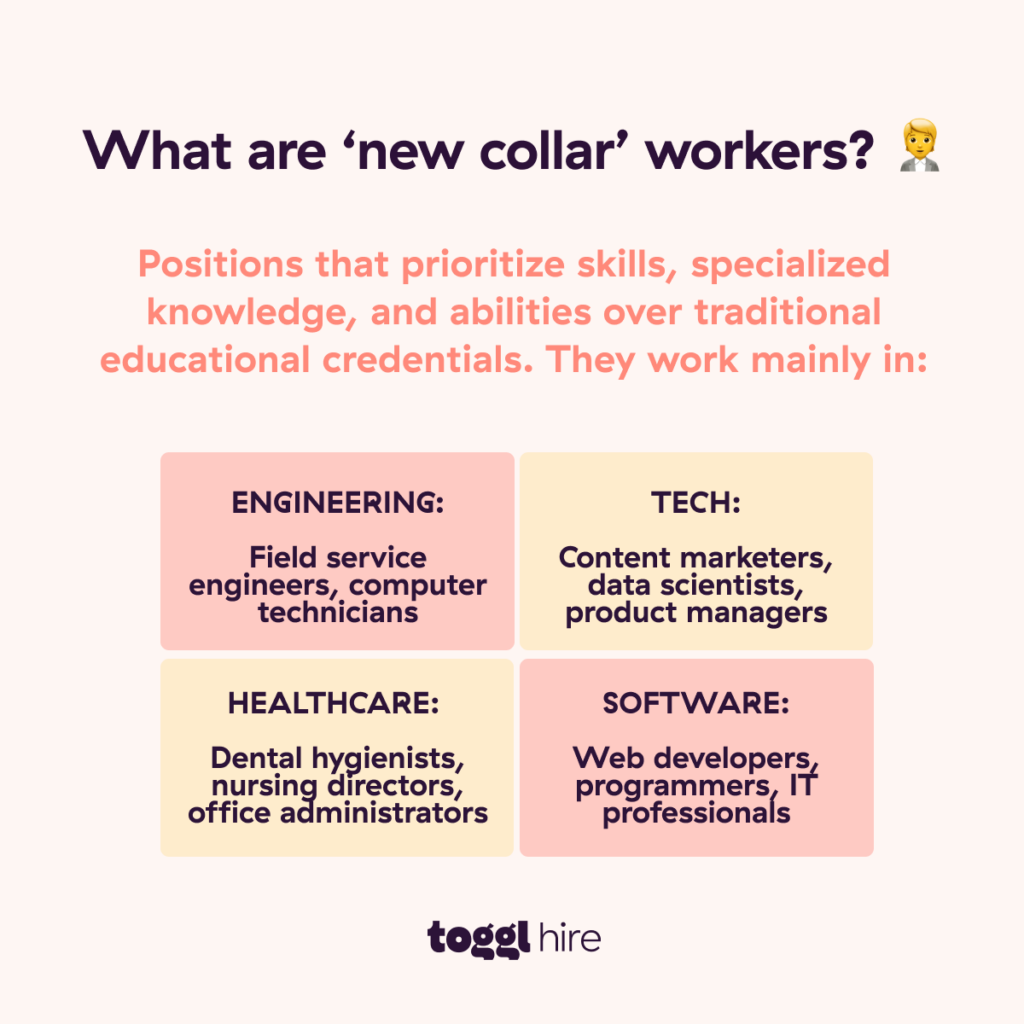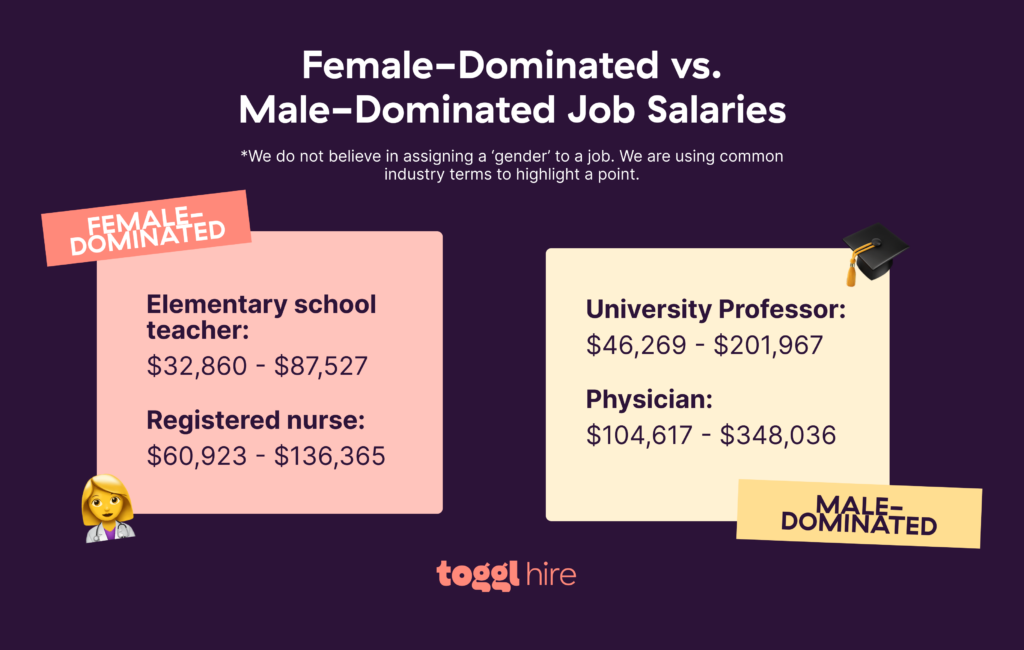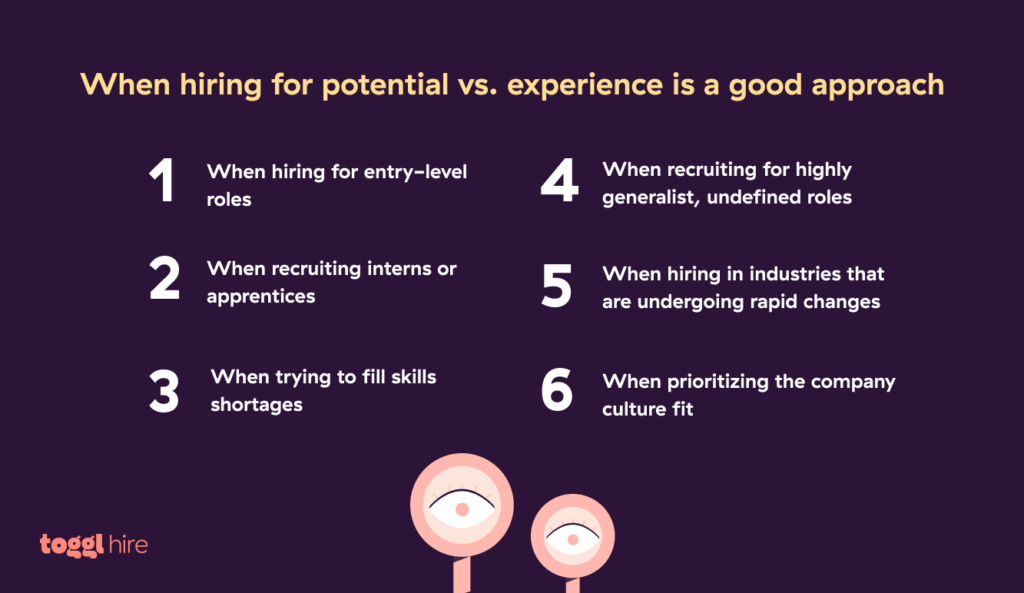Most people have heard of blue and white-collar jobs. But what about pink? As you may have guessed, pink-collar jobs refer to female-dominated roles and professions, although the exact nature of these professions has shifted over the years.
While we’ve made strides in achieving gender parity at work, modern gender dynamics and expectations continue to evolve. Are these terms still relevant in the 21st century, though? Let’s find out as we explore practical ways companies can encourage gender equity in 2024 and beyond.
TL;DR — Key Takeaways
Pink collar refers to female-dominated jobs. These jobs tend to be on the lower rungs of the healthcare ladder, care-based positions, or jobs in service-based industries like beauty and hospitality.
They tend to be undervalued and underpaid. Some reasons for this include an over-reliance on tips, scope creep without extra pay, and a perception of the work as less valuable.
This has negative consequences for women’s labor market outcomes and economic independence, which can lead to other problems.
Compared to blue-collar workers, who have jobs that are more physically demanding, these jobs can be very emotionally laborious, which can have knock-on effects on workers’ mental well-being and work-life balance.
Companies can do their part by introducing fair hiring practices aimed at improving gender parity across all sectors.

What are pink-collar jobs?
The phrase “pink collar jobs” refers to positions that women typically hold and are typically care- and service-oriented. It originated with sociologist William J. Baumol in the 1960s and gained popularity thanks to American author and social critic Louise Kapp Howe.
In the 1940s, 5 million women filled the roles left behind by men called to war. During this time, as much as 90% of nurses, midwives, telephone operators, secretaries, domestic service workers, and boarding housekeepers were women.

Interestingly, female-dominated positions shift with changing social tides. Today, most pink-collar jobs are in the childcare and healthcare professions. Some roles, such as secretaries and teachers, have remained stable over the decades, but others have seen shifts, with more men entering the industry.
A growing need for workers in particular industries helps to explain some of the reasons for these shifts in employment. Other key factors influencing this shift include a decline in the stigma of men in a “woman’s profession” and evolving gender expectations.
Ultimately, challenging gender stereotypes remains important in pink-collar job recruitment. Focusing on individuals’ skills and capabilities, instilling inclusive hiring practices, and fostering diversity and equity in the workplace are key to building fair and fulfilling workplaces for everyone (which is what we’re all about!)
Pink collar vs. blue collar vs. white collar jobs
The terms white and blue collar worker emerged in early 20th century America, inspired by the actual color of workers’ collars. Uniforms were given blue-collar for manual laborers, and white dress shirts with white collars were reserved for managerial and clerical workers.
These associations, however, have persisted to the present day, with “blue collar” workers now associated with tradesmen, like electricians, plumbers, carpenters, construction workers, or manufacturers. And “white collar” workers associated with office-based work, such as accountants, managers, businessmen, bankers, lawyers, engineers, and the like.
These classifications may have once helped us understand the labor market’s diversity. However, whether they’re still useful today is debatable. Not only because they carry negative connotations (particularly for blue and pink-collar workers), but also because the nature of work has changed, blurring the lines between categories.
To summarize, here’s how the traditional classifications compare to one another:
| Pink Collar Jobs | Refers to roles traditionally associated with caregiving or service-oriented tasks, often healthcare, education, childcare, and administrative support. Historically, they are roles that were almost exclusively occupied by women. However, with growing inclusivity, changing demographics, and evolving social-gender expectations, this association is slowly shifting. |
| Blue Collar Jobs | Refers to those who perform manual labor in physically intense roles, often in the manufacturing, construction, mining, and maintenance sectors. The work is usually very physical, with a relatively high risk of injury. Apprenticeships or other forms of specific skills training are typically required. |
| White Collar Jobs | Refers to office-based roles requiring formal education and often involving managerial, administrative, or specialized tasks. Traditionally, these roles were associated with higher social status. With education and remote work opportunities becoming increasingly accessible, the barrier to entry for these kinds of jobs is arguably lower than ever. |
How “collar” jobs are evolving
With rapidly advancing technologies and growing social movements, the distinction between traditional categories of work is becoming less clear. Historical associations of the white-collar worker— as a salaried professional with higher income, better education, and overall higher social status—are often no longer true.
To give some examples, many white-collar jobs no longer require a formal education or master’s degree, while many blue-collar jobs, especially in expensive zip codes, pay a much higher hourly wage compared to the average white-collar role.
This increasing overlap begs the question—are these distinctions even still relevant?
Classifying jobs in this way also impacts cultural perceptions of the work itself. Painting one as more desirable than the other devalues the meaningful work that keeps our society and economy standing. All work brings something to the table without which we couldn’t live like we do.
Up and coming: New collar jobs
A more recent term you might’ve come across is “new collar” workers.
This newer term describes positions that prioritize skills, specialized knowledge, and abilities over traditional educational credentials like a high school diploma or four-year college degree.
In the internet age, where a college degree doesn’t carry the same weight as it did 50 years ago and you can learn as much on YouTube as you can at any standard university, these kinds of roles are becoming increasingly relevant.
Employers are looking more and more for practical ability than theoretical knowledge, and offering training programs to help plug any skills gaps. This shift is opening doors for many to enter high-paying, satisfying careers without the burden of student debt. After all, everything exists on the internet, right?

Examples of pink-collar jobs
According to the US Bureau of Labor Statistics, the top five pink-collar jobs in 2023 were:
Preschool and kindergarten teachers
Dental hygienists
Speech-language pathologists
Dental assistants
Childcare workers
In each of these positions, over 90% of professionals occupying these roles in 2023 are female. Here’s a more detailed breakdown by sector.
Healthcare
Nursing: Though still female-dominated (89%), nursing is experiencing an increase in men joining its ranks. It’s a promising career for any gender, offering a medical pathway without the lengthy training post-high school.
Medical Assistant: Currently, 93% are women, but rapidly growing compared to other areas. These professionals support doctors in outpatient settings, handling tasks like patient histories, lab work, explaining procedures, and offering medical guidance.
Education
Teaching: K-12 teaching has long been female-dominated. In the 1940s, 75% of teachers were women, dropping slightly to 70% today. However, women remain dominant among pre-school and kindergarten teachers (96%), falling to just 57% for secondary school.
Educational Administrator: An educational administrator ensures schools meet educational standards, coordinating academic, administrative, and support functions. These roles are typically female-dominated.
Carers
Social Worker: The gendered nature of care work has harsh implications for women’s labor market outcomes, economic independence, and gender equality. Globally, women make up 67% of the care workforce.
Domestic Worker: 77% of the domestic workers globally are women.
Childcarer: 97% of childcare workers are women, globally.
Average pay for pink-collar jobs
It’s a fact that pink-collar jobs are underpaid. But why? A few reasons could be:
A reliance on tips: Many pink-collar industries, such as hospitality and beauty, are paid by the hour and are tip-heavy. This means the majority of workers’ wages usually come from tips rather than a fixed salary. Taking a day off also means a hit to your wages, in contrast to salaried employees.
Lower perceived value: Female-dominated positions such as therapists, teachers, social workers, and childcarers might be perceived as less physically strenuous, which could impact the perception of their worth. This could be used as an argument to justify lower pay.
Fewer women in white-collar positions: Typical white-collar professional jobs in male-dominated industries like finance and business management offer limited flexibility for working moms. As a result, the number of women at the top today remains lacking.
Scope creep: Female-dominated professions are vulnerable to scope creep — aka getting extra job tasks assigned that are beyond the scope of the original job description — without a reflection in remuneration.
Here are examples of 2 pink-collar jobs compared to their male-dominated counterpart and average pay ranges in the USA in 2024 (according to Indeed):

Are pink-collar workers treated unfairly?
As we’ve seen, pink-collar jobs refer to female-dominated positions. And while we’ve made progress on the gender equality front, the sad reality is that these positions remain underpaid and undervalued compared to positions traditionally held by men, even in the 21st century.
Many of these female-dominated roles involve heavy emotional labor, which has knock-on effects on worker well-being. For example, a recent report found that over half of therapists have recently experienced some kind of burnout.
Top this with the fact that women often work a “second shift” of unpaid labor when they come home, and you can understand how, despite our progress, the deck of gender parity remains stacked against women.
Women aren’t the only victims of structural patriarchy in the workplace. Men entering female-dominated fields also face discrimination. Just search “male secretary” in Google and you’ll find plenty of anecdotes illustrating the struggle men face fighting against stigmas of pursuing “women’s jobs.”
This is why reassessing the value society places on these essential roles is so important. It’s high time workers in pink-collar fields receive the recognition and compensation they rightfully deserve, supporting a more inclusive and equitable workforce.
How to hire pink-collar workers
So-called pink-collar workers play a huge role in service-oriented sectors. Hiring for such positions can require a slightly different approach, often focusing more on soft skills. Here are some tips to succeed in hiring such essential talent effectively (regardless of their gender—c’mon).
Use inclusive language in job descriptions
Your job description is the first interaction you have with a potential hire. Using gender-neutral and inclusive language can immediately open the door to attracting a diverse pool of applicants. Avoid jargon at all costs. Focus instead on the core skills, employee strengths, and values that align with the company culture and the job’s demands.
Promote inclusivity and diversity
Emphasize your organization’s commitment to inclusivity and diversity. Showcasing policies that support diverse needs and lifestyles, such as parental leave for birthing and non-birthing parents, and offering flexible schedules to work around childcare duties for men and women. Of course, for this to be effective, it cannot be performative. Embody these values to the core of your company, or candidates will sniff it out right away.
Try integrating blind hiring into your recruitment strategy. The practice is gaining in popularity among HR leaders as a way to remove hiring bias and achieve a more diverse candidate pipeline.
Focus on skills and potential during interviews
When hiring pink-collar workers, it is important to value practical skills and potential over formal qualifications. Be open to candidates without a college degree, as well as those with an associate degree from community colleges. During the hiring process, you could include behavioral interview questions to assess situational judgment and get a feel for how candidates would handle real-life scenarios.

Offer competitive compensation and growth opportunities
No one likes feeling undervalued. Make sure your compensation package is attractive, and opportunities for career progression are clear from the outset. Benefits tailored to candidates’ needs, like health support and development programs, are crucial for retention. It goes without saying that pay should be fair, regardless of gender.
Hire fairly with Toggl Hire
Though a lot has changed since the 1940s, women still dominate healthcare, service, and care-oriented sectors. These so-called “pink collar jobs” are generally underpaid, undervalued, and carry a high emotional burden.
That being said, social trends are shifting, gender expectations are eroding, and the lines between blue, white, and pink-collar jobs are becoming increasingly blurred.
Companies can do their part to improve gender parity by building fair and equitable hiring processes, starting with gender-neutral job descriptions all the way to attractive compensation packages and paths to progression determined by skills, ability, and little else.
Get started today with a free Toggl Hire account, and see for yourself how skills testing can help you hire fairly for any kind of job.

Julia is a freelance writer and fierce remote work advocate. While traveling full-time, she writes about the intersection of technology and productivity, the future of work, and more. Outside work, you can find her hiking, dancing, or reading in a coffee shop.





